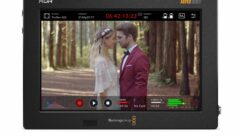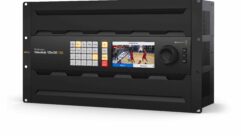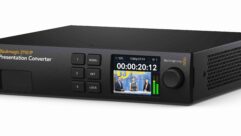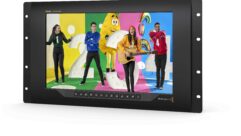Video Routers
Nov 1, 2003 12:00 PM,
David Riffle
Whenever video from more than one source must be accessed or when more than one source must be accessed at more than one location simultaneously, some method of video routing must be employed. There are a handful of ways to accomplish this: manually reconfigure the equipment cabling as needed, use patch bays, use built-in input selectors, and so on. But the most straightforward, user-friendly, mechanically reliable, and versatile method is to use a video router. This is especially applicable for an installation that has more than a few video sources and viewing locations or for the need to view different sources simultaneously at different locations. In this article, I will be discussing the principles of small- to medium-size video routers for use in presentation and viewing environments, small edit suites and duplication facilities, and niche applications in broadcast facilities.
THE BASICS
There are two fundamental types of video routers. They are both identical in terms of routing the video from a number of sources to a destination, but they differ in the number of destinations they serve.
A video switcher is a routing device that allows the selection of any one of a set of sources and routes the selected source to usually one or two dedicated destinations. Video switchers are designed to provide input video source selection for a single viewing location or a set of devices that require the same video source at the same time.
A video router is a routing device that allows the selection of any one of a set of sources and routes the selected source to any of a set of destinations. Each destination is independent and isolated from each of the others. This type of router can be visualized as a matrix that can serve any input to any, or all, of the outputs. For this reason they are often called matrix video routers.
Video routers are manufactured in a wide variety of sizes and styles, as well as signal formats. Many have the flexibility to mix signal formats in the same frame, which means they could be used to route both digital and analog video, VGA and audio, and so on. Others are dedicated to a single format. Some, usually video switchers, are highly specialized, such as those that can automatically switch from one source to another if the signal is lost on the original input. Because routers are so central to an installation’s layout, many are designed to allow expansion to add a greater number of inputs, outputs, or both, as future needs demand.
Routers include the ability to structure the input and output routes into “levels.” All routers have levels, even if they operate on only one. The purpose of a router level is to ensure that one set of video source signals can only be routed to one set of video signal destinations. The need for this feature is apparent when the router can accommodate a mix of video formats in one frame; it would be undesirable to inadvertently route a digital video source to an analog video destination, for instance. But it may not be as apparent that this feature can also simply be used to restrict a set of video sources to a designated set of video destinations. For example, one router may serve two different floors in a hospital; one floor has video sources that need to be accessed by viewing locations only on that same floor, whereas the other floor has the same requirements for its own source and destination video.
Video routers and switchers can actually be mechanical devices, which means they will make the routing signal paths through a mechanical switch. These are seldom used for any kind of demanding application, because the mechanical contacts become electrically noisy, and in time the actuators tend to be temperamental. Active, electronic switching is quieter and far more reliable.
The architecture of a video router, then, is this: one or more sets of source signals of one or more types of signal format (frequently including non-video formats), which are independently routable to one or more sets of signal destinations. Additionally, many routers can be software configured to list sources and destinations by user-defined names, route groups of sources to specified groups of destinations at once (usually with a single control stroke, called a salvo), apply lockout protection to certain sources or destinations, and perform many other functions. This is the domain of the control system of the router.
Every router must have some sort of control system. These range from a simple automatic switch from one input to another, determined by manufacturer-established criteria, to a series of remote-control panels, each of which can perform any routing connection available. When a routing connection is made in coincidence with the vertical interval of the video sources, it is appropriately said to be a vertical interval switch. This type of switching is important when a clean, professional output stream of video is required for the sake of destination equipment stability or simply for visual effect.
Larger routers will provide for access by a computer terminal or application, for maintenance purposes, or so that various software parameters can be configured (such as source and destination names). This access could be through a computer serial port connection or even a LAN connection. Very large video routers can have highly complex control systems, normally requiring some operator training or factory engineering setup assistance.
Control panels are variants of three types: a push-button for each source video sent to one video destination (called a button per source (BPS) panel), a keypad that can choose any source video and route it to any video destination (called an XY panel), or a computer application that simulates one of the other two.
VIDEO ROUTER SELECTION
A video router really justifies itself when the operating situation requires that a clean, reliable switch between a number of video sources be made to a particular location or more. This may be a presentation room, a CEO’s office, a classroom, an edit suite, a selection of VCRs, or all of those at once. In each case, the first step is to define the number of sources and destinations, signal formats, connector types (of the source and destination equipment), levels required (for instance, an audio as well as a video level), the amount of control configuration (software configurable control parameters, salvos, or levels), and the type and number of control panels required. Resist the temptation to determine the budget constraints first. It will be much better to obtain a router that meets your requirements for the best price available than to obtain a router that will be a high-profile source of frustration for the price budgeted. Typically, routers are so central to the video signal paths in a facility that once installed, they are not easily replaced or even supplemented. Your initial purchase selection should be made with great care taken to determine your current and future needs, as well as the needs that will arise after you make them possible with the new capabilities a video router affords.
Next, list the location of the video source and viewing or recording sites. Find a location for the router that is as centrally located as possible to all the source and destination equipment, so the lengths of cable runs can be minimized. A router will need to be mounted in an equipment rack of some sort, and that can be a full-size rack in a computer room, an under-the-counter rack in a console, or a structure in a phone closet. You will need to run a lot of cabling to the router, so you will also need space for that. Make sure that you allow enough space for access to the router connections, because that will allow quick cabling changes or additions in the future.
Now you will be able to prepare a list of materials (such as cables and connectors), any space improvements (such as electrical power), and a list of operating requirements your router will need to meet. Video routers are robust, so failures are few, but it is wise to filter your list of equipment manufacturers, focusing on the ones that you can readily contact and which have a reputation for supporting their products in the field. You can now request equipment quotes, and demonstrations if possible, and then present your choices for budget approval.
MANUFACTURER RESOURCES
When several sources are to be routed to only a small number of closely spaced destinations, it makes sense to use video switchers at each destination. These are compact routers and normally have simple front-panel controls. If the destinations are widely separated or are numerous, then a video matrix router is more appropriate. These range from compact sizes approximating the video switcher models to multiframed systems supporting a wide range of signal formats and levels. Control panels for matrix routers tend to be remotely located near many of the destinations, and in some the control systems may be located in external computers. Many manufacturers make both matrix video routers and video switchers, whereas some specialize only in control systems for routers. Here are a few examples.
Adrienne Electronics builds the AEC-1 and AEC-2 video switchers, which are high-quality analog video and stereo audio 10-by-1 and 10-by-2 switchers. These are excellent utility switchers, compact and straightforward. They include front-panel control panels, with audio breakaway and lighted indicators to illustrate, at a glance, the current routing configuration.
Altinex makes several sizes and models of matrix routing switchers able to support analog audio, composite video, S-video, component video, RGSB, RGBS, and RGBHV video. Sizes are from 4-by-2 to 16-by-16, and features such as memory presets and IR control offer a lot of flexibility for analog signal routing. The V-Matrix model is modular, which allows a customized configuration of input and output formats. The Homerun series is particularly well featured and compact. Adrienne’s Web site includes a nice description of matrix video switchers and a guide to ease your selection.
AutoPatch produces a rather extensive product list of video routers and switchers. These range in matrix sizes from the Half-Y 6-by-2 model to the Epica 256-by-256 model. Its Modula-series matrix routers are flexible in configuration of the number of inputs and outputs, as well as the signal formats and levels. They can support virtually any format of analog and digital audio and video, including HDTV, with sizes to 32-by-32 RGBHV.
Buf Technology specializes in control systems, and a particularly useful supplement to an existing router control panel configuration is the BUFMC router control application. This application runs on a variety of Windows operating systems and can be a method of putting a router control panel at any appropriate PC location. It is a graphical user interface and uses simple icons and routing diagrams to direct source/destination routing choices. This application is also touch-screen ready.
Burst Electronics manufactures a set of small utility video switchers, which can be remotely controlled. The VS4×1, VS8×1, and VS8×8 switchers are excellent for analog composite signal routing, such as source monitoring.
Comprehensive Video Group has a wide assortment of small utility video routers and switchers. Matrix routers are available in sizes from 4-by-4 to 8-by-8, and video switchers are available in sizes of 2-by-1 to 6-by-2. These devices support a variety of analog audio and video formats, including VGA formats. Comprehensive also has the CVG-FW4×4, a small 4-by-4 passive FireWire router that can make one of any of the four routes at a time.
Covid has a series of composite video matrix routers, such as the CVD5100, which are available in configurations from 4-by-4 to 8-by-8. These routers feature vertical interval switching, front-panel control, memory presets, and programmable hold times.
Crestron Electronics has the CNX-PVID8×3 and CNX-PVID8×4 video routers that are configurable for a variety of analog formats but are also capable of outputting these signals over Cat-5 wiring to remote destinations. Used with its Cat-5 video receivers allows relatively simple video wiring to be used for long runs. This is especially practical when component video must be routed through difficult or electrically noisy environments, because the video is distributed over balanced lines.
Datatek makes video routers for medium to small installations, available in a range of analog and digital signal formats. These are high-quality, compact routers, such as the 32-by-32 D-2600 series, and are accompanied by a nice range of control panel options.
Extron Electronics provides a cross-reference on its Web site for choosing the router most appropriate for your needs. You can confidently select among the number of video inputs and outputs, signal formats, bandwidths and router control types. They also provide a short tutorial to describe switchers and routers, as well as how they are used.
Folsom Research has introduced the MatrixPro wideband router. This router can be configured for sizes 12-by-4, 12-by-8, 16-by-8, or 16-by-16 and has universal inputs that can support analog computer, composite video, S-video, component HDTV, RGBHV, and analog audio formats.
FSR produces several router models that are specifically designed to accept a range of analog video input signals and resolutions and then scale each to a user-programmed output resolution. This can be combined with built-in effects to provide seamless transitions between source video to destination equipment such as projectors, multisync, and plasma monitors — equipment that does not behave well with switching disturbances or when changing resolutions. The Compass presentation switcher is one such example, as is the newest 4-by-1 A/V switcher, the MAS4100A.
Hall Research Technologies manufactures routers and switches from 2-by-1 to 10-by-12, designed to support VGA, RGBS, or RGBHV. The VSM-1012 is its high-performance 10-by-12 matrix router with RGBS BNC connections.
Hotronic adds a twist to the usual video switch by inserting a built-in TBC/Frame synchronize into each of the two outputs of its 8-by-2 AX-81 video router. It can also be equipped with an audio level to follow the video switch. The AS800 is a digital video 8-by-8 router with automatic cable equalization. Both have front-panel controls and allow for connections to remote-control systems.
Key Digital Systems manufactures a small 8-by-3 matrix routing switcher, the KD-MSW8×3, which is capable of routing component or composite video signals as high as HDTV resolutions, along with pulse-code-modulation digital audio. It can be controlled by front-panel switches, IR remote, or serial control and uses front-panel LEDs to display the routing paths.
Knox Video Technologies has a considerable assortment of video routers designed for analog and digital video formats, with sizes from 2-by-1 to 64-by-64. The MediaFlex series are modular analog routers, configurable for composite, component, and VGA formats and include audio volume and tone control on each output. Equipped with dual LCD displays, a lot of information is displayed on the front panel.
Kramer Electronics has a vast assortment of video routers designed for analog and digital video formats, with sizes from the VP-211N 2-by-1 to the VS-1616SDI at 16-by-16. Many of these routers are expandable, have remote-control panel connections, and have genlock capability. The VP-25 is a presentation switcher with four analog composite, component, VGA video, with corresponding balanced audio inputs to one user-selectable, scaled output.
Leitch provides a series of products based on its Mix Box line. These are small routing switchers ranging from the 4-by-1 VSR-4041MB digital video router to the quad 2-by-1 ASM-1321 mono audio router. They support digital and analog video and analog audio signal formats. The Mix Box units are designed for standalone applications, but the same routers are manufactured in a plug-in circuit board form factor, which can be used with Leitch’s 6800- or 7000-series frames. They are all available with local or remote push-button control panels.
Magenta Research manufactures the MultiView Matrix 8×8, which is a Cat-5 video router. It has front-panel controls that also display the routing connections in use, is compact, and can route signals with resolutions from NTSC to UXGA. The MultiView series uses Cat-5 transmitters and receivers to convert the video for Cat-5 distribution and routing.
Miranda has a line of compact video routers, the Network series, which are so thin they can be mounted in the back of a fully populated equipment rack. They are full featured, with many levels, control options, and video format choices. These formats include analog video, composite and component, analog audio, digital audio and video (to 1.5 gb/s), and telecom data at 34/45 Mb/s and 140/155 Mb/s.
Pesa has several video router lines, primarily designed for the broadcast industry. Most of these are large matrix video routers, but the Bobcat and LNS8 models are 1 RU, 16(8)-by-2 switchers with front-panel controls and an external serial control port. The Bobcat can support analog HD and digital SD formats. Moving up from there, the company has matrix router model lines for matrix sizes 8-by-8 through 1,024-by-1,024. There are model configurations for video and data formats from 3 Mb/s to 1.5 Gb/s, AES digital audio, analog audio, Time Code, Machine Control Data, analog RGB, RGBS, or RGBHV.
Sierra Video Systems makes a range of video router families designed for needs from 8 input switchers to 128-by-128 multi-level matrix routers, as in the Yosemite family. The Sierra Pro family is designed for wideband analog component video routing needs, in sizes from 8-by-8 to 32-by-32, and the Tahoe family supports analog composite and component and now SD/HD digital video signals. An elegant assortment of control panels is also available.
Sony has a set of video routing switchers that can be configured for analog audio, composite video, Time Code, Machine Control Data, AES digital audio, and SDI digital video. Some of these can be cascaded to form much larger matrices if needed.
Ross Video manufactures a small video routing switcher series, the 16-by-1 and 16-by-2 Kangaroo series, capable of HDTV, serial digital video, and audio signal formats. These switchers are 1 and 2 RU respectively and can be configured with multiple levels. The larger Kondor matrix router series is also capable of analog video, audio, and machine control levels. A flexible control system, Geneos, adds hardware and software control panels and permits network-based control, which allows router control over LAN or WAN networks.
Video Accessory Corp. (VAC) manufactures some compact, encapsulated video switches designed for tough, limited space and demanding environments, such as remote broadcast locations. The VAC ProSeries composite Automatic Video Switch line are switches that can automatically switch from the main composite video input to the auxiliary if the main input signal is no longer present and provide a status output for remote monitoring of the switch position. Other products in the ProSeries models can support analog component, Y/C and analog audio, and a choice of power supplies.
Please gather as much information as possible about the video routers that meet your needs. From here a good place to start is a visit to any of these router manufacturers’ Web sites.
David Riffleis the chief technology officer of Video Arts, a digital video production facility in San Francisco.
For More Information
Adrienne Electronics
www.adrielec.com
Ž 216
Altinex
www.altinex.com
Ž 217
AutoPatch
www.autopatch.com
Ž 218
Burst Electronics
www.burstelectronics.com
Ž 219
Buf Technology
www.buftek.com
Ž 220
Comprehensive Video Group
www.compvideo.com
Ž 221
Covid
www.covid.com
Ž 222
Crestron Electronics
www.crestron.com
Ž 223
Datatek
www.datateknj.com
Ž 224
Extron Electronics
www.extron.com
Ž 225
Folsom Research
www.folsom.com
Ž 226
FSR
www.fsrinc.com
Ž 227
Hall Research Technologies
www.hallresearch.com
Ž 228
Hotronic
www.hotronics.com
Ž 229
Key Digital Systems
www.keydigital.com
Ž 230
Knox Video Technologies
www.knoxvideo.com
Ž 231
Kramer Electronics USA
www.kramerelectronics.com
Ž 232
Leitch
www.leitch.com
Ž 233
Magenta Research
www.magenta-research.com
Ž 234
Miranda
www.miranda.com
Ž 235
Pesa Switching Systems
www.pesa.com
Ž 236
Ross Video
www.rossvideo.com
Ž 237
Sierra Video Systems
www.sierravideo.com
Ž 238
Sony
www.sony.com
Ž 239
Video Accessory Corp.
www.vac-brick.com
Ž 240
Ž Circle this number on Reader Service Card or visit freeproductinfo.net/svc










